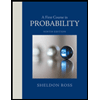
A First Course in Probability (10th Edition)
10th Edition
ISBN: 9780134753119
Author: Sheldon Ross
Publisher: PEARSON
expand_more
expand_more
format_list_bulleted
Question
![The random variable Z is defined as a function of the random variables X and Y as follows:
Z = 1 Moreover, it is known that E[X|Z] = Z² and that Z is zero mean. Compute E[Y|Z = 2]
Y+1
and E[Y].](https://content.bartleby.com/qna-images/question/71f6a4b8-527f-4030-b85a-828002701c6f/c7863c7b-f304-44c3-8657-db0c6f8b9838/smb4lcd_thumbnail.png)
Transcribed Image Text:The random variable Z is defined as a function of the random variables X and Y as follows:
Z = 1 Moreover, it is known that E[X|Z] = Z² and that Z is zero mean. Compute E[Y|Z = 2]
Y+1
and E[Y].
Expert Solution
This question has been solved!
Explore an expertly crafted, step-by-step solution for a thorough understanding of key concepts.
Step by stepSolved in 4 steps with 18 images

Knowledge Booster
Similar questions
- If X and Y are Gaussian random variables then what is E[XY]?arrow_forwardQ1. let Y₁ < Y₂ < Y3 < Y4 < Y5 are the order statistics of the random sample of size 5 from the distribution : f(x) = 3x², 0arrow_forward2. Let X and Y be independent random variables with E[X] = 4, Var[X] = 84, E[Y] = 6, and Var[Y] = 54. Find E[5X + 2Y - 18] - b. Find E[-3Y+X+3] -a. -с. Find E[X2] d. Find ox e. Find E[Y2] f. Find Oy g. Find Var[X+3Y - 6] h. Find Var[3X - 2Y + 35] Find E[(2X - 8)/5] j. Find Var[(2X - 8)/5] i.arrow_forward
- Given that the MGF of the sum of independent random variables is the product of individual MGFs. If X and Y are independent random variables, then MX+Y(t) = MX(t)MY(t) Prove this statement.arrow_forward. Let X and Y be random variables and let AE B. Prove that the function X(w), if we A, Y(w). if w€ AC is a random variable. Z(w) =arrow_forwardSuppose the discrete random variables X and Y are jointly distributed according to the given table. a. Compute the expected values E(X) and E(Y ), the variances V (X) and V (Y ), and also the covariance Cov(X, Y ) of X and Y. b. Determine whether X and Y are independent. c. Let T = X − Y . Compute E(T) and V (T)arrow_forward
- 3. Determine the value c so that each of the following functions can serve as probability distributions of the discrete random variable X: a. f(x) = c(x² +4) for x = 0,1, 2, 3; 3 b. f(x)%3Dс for x= 0,1, 2 3-xarrow_forwardSuppose X and S2 are calculated from a random sample X₁,..., Xn drawn from a population with finite variance o2. We know that ES2 = o². Prove that ES ≤ 0, and if o2 > 0, then ESarrow_forwardYou are given the following information regarding random variable X: I. E[X] = 2 II. E[X³] = 10 III. Var[X] = 1 Find E[(X – 1) ³].arrow_forward
arrow_back_ios
arrow_forward_ios
Recommended textbooks for you
 A First Course in Probability (10th Edition)ProbabilityISBN:9780134753119Author:Sheldon RossPublisher:PEARSON
A First Course in Probability (10th Edition)ProbabilityISBN:9780134753119Author:Sheldon RossPublisher:PEARSON

A First Course in Probability (10th Edition)
Probability
ISBN:9780134753119
Author:Sheldon Ross
Publisher:PEARSON
